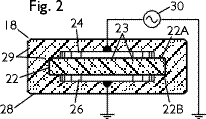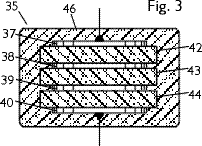ELECTRON FIELD GENERATOR
Patrick Flanagan's US Patent # 4,743,275 of May 10 1988.
 Referring to fig.2, the field emitter 18 may be seen to comprise a slab or sheet 22 of a solid dielectric material such as glass, paraffin, acrylic, epoxy or other suitable dielectric in which a plurality of small particles or granules 23 of conductive or semiconductive material are dispersed. A pair of planar electrodes 24 and 26 are mounted to the opposite faces 22A and 22B of the member 22 to form a capacitor which may be encapsulated in an insulator 28. The member 22 is square when viewed from the top as are the electrodes 24 and 26, but these members may, if desired, be circular or of some other suitable shape. The corresponding dimensions of the dielectric member are greater than those of the electrodes 24 and 26. The insulator 28 is also a solid dielectric material such as glass, paraffin, acrylic, epoxy or other suitable dielectric and may be DOPED so as to include conductive or semiconductive particles or granules 29 dispersed therein.
Referring to fig.2, the field emitter 18 may be seen to comprise a slab or sheet 22 of a solid dielectric material such as glass, paraffin, acrylic, epoxy or other suitable dielectric in which a plurality of small particles or granules 23 of conductive or semiconductive material are dispersed. A pair of planar electrodes 24 and 26 are mounted to the opposite faces 22A and 22B of the member 22 to form a capacitor which may be encapsulated in an insulator 28. The member 22 is square when viewed from the top as are the electrodes 24 and 26, but these members may, if desired, be circular or of some other suitable shape. The corresponding dimensions of the dielectric member are greater than those of the electrodes 24 and 26. The insulator 28 is also a solid dielectric material such as glass, paraffin, acrylic, epoxy or other suitable dielectric and may be DOPED so as to include conductive or semiconductive particles or granules 29 dispersed therein.
As shown, the electrode 24 is connected to one terminal of a high voltage, high frequency source of electric energy 30, and the electrode 26 is connected via ground to the other terminal of the energy source 30. The voltage applied across the emitter has a frequency of at least 20 kiloHertz and a voltage of at least 5000 volts rms.
The reason why the field strength is increased by the presence of conductive particles in the dielectric material is not fully understood. However, comparative tests have proven that the electric field is strengthened and significantly improved air purification is achieved when such materials are dispersed in the dielectric, and it is believed that the work function of the dielectric is altered by the added material and this results in the increased emission from the device.
 Referring to fig.3, there is shown a negative electric field emitter 35 which comprises a plurality of planar metallic electrodes 37, 38, 39 and 40 separated by a plurality of flat dielectric members 42, 43 and 44. The electrodes and the dielectric members are encapsulated in an insulating material 46. Conductive leads extend from the electrodes 37 and 40 through the insulating material 46 for connection of the field emitter 35 to a high frequency, high voltage source to develop a generally toroidal electric field around the field emitter 35…
Referring to fig.3, there is shown a negative electric field emitter 35 which comprises a plurality of planar metallic electrodes 37, 38, 39 and 40 separated by a plurality of flat dielectric members 42, 43 and 44. The electrodes and the dielectric members are encapsulated in an insulating material 46. Conductive leads extend from the electrodes 37 and 40 through the insulating material 46 for connection of the field emitter 35 to a high frequency, high voltage source to develop a generally toroidal electric field around the field emitter 35…
In order to substantiate the fact that doping of the insulator with different non-dielectric materials alters the resultant field and in some cases increases the field strength a substantial amount, several different experiments were conducted. In making these experiments, three different emitters of identical size and shape were constructed. The dielectric slabs were circular being 80 mm in diameter and 15 mm thick. The plates were 63 mm in diameter. In one emitter, the dielectric was a pure epoxy. In a second emitter the dielectric was epoxy containing ten percent by volume of small lead spheres dispersed throughout the epoxy so as to be insulated from one another. The spheres had a diameter of 0.7 mm. In a third emitter the epoxy was doped with SILICON CARBIDE GRANULES having a size of 75 mesh. These granules were of the type used in lapidary grinding and thus contain a substantial amount of elemental impurities wherefor the material is actually a crude semi-conductor. It is also PARAMAGNETIC.
The emitters were connected across a high frequency power supply of 24 kV at 44 kiloHertz in the manner described in my US Patent # 4,391,773 using a Kiethly electrometer and an ion/electron probe.
[Additional data from his other US patent 4,391,773…When a power source having a voltage of 24 kilovolts at a frequency of 38 kiloHertz was used, readings as high as 6.38X10:³ ions per cm² were measured at a distance of 50 cm from the device 10. This negative field is sufficiently strong to purify air by discharging particulates entrained therein and to destroy bacteria in the air. An input voltage of 5 kilovolts at a frequency of about 20 kiloHertz produced a negative field which appears to have about the minimum strength for purifying air. The measured field strength at 50 cm from the device was 500,000 ions per cm² per second.]
At a distance of ten centimeters from the emitters the following measurements were made.
Pure epoxy dielectric 2.98X10:: electrons/cm²
Epoxy with lead spheres 3.97X10:: electrons/cm²
Epoxy with silicon carbide 4.76X10:: electrons/cm²
It may thus be seen that the addition of conductive or semiconductive or PARAMAGNETIC particles to the dielectric greatly increases the field strength of the field generated by the emitter.